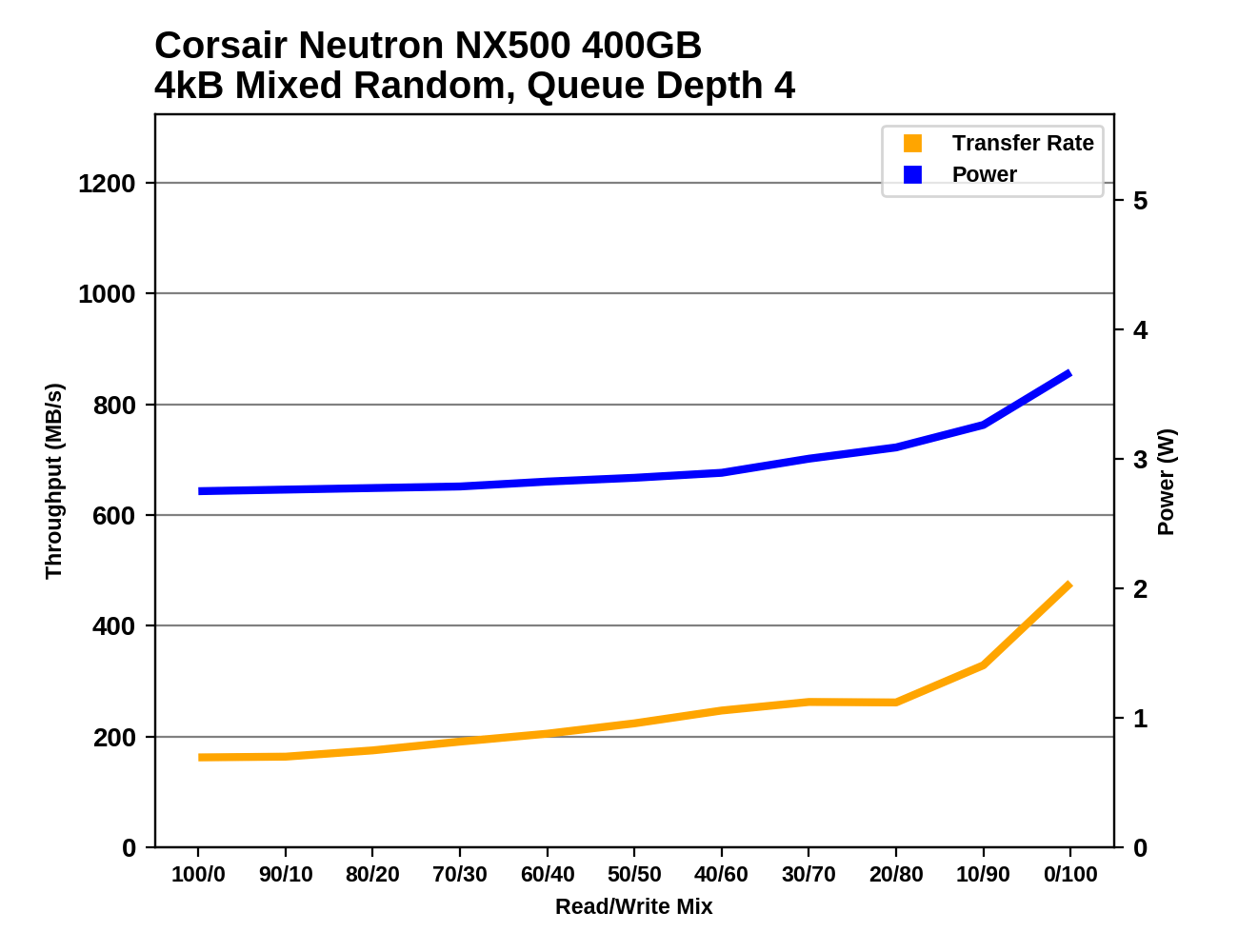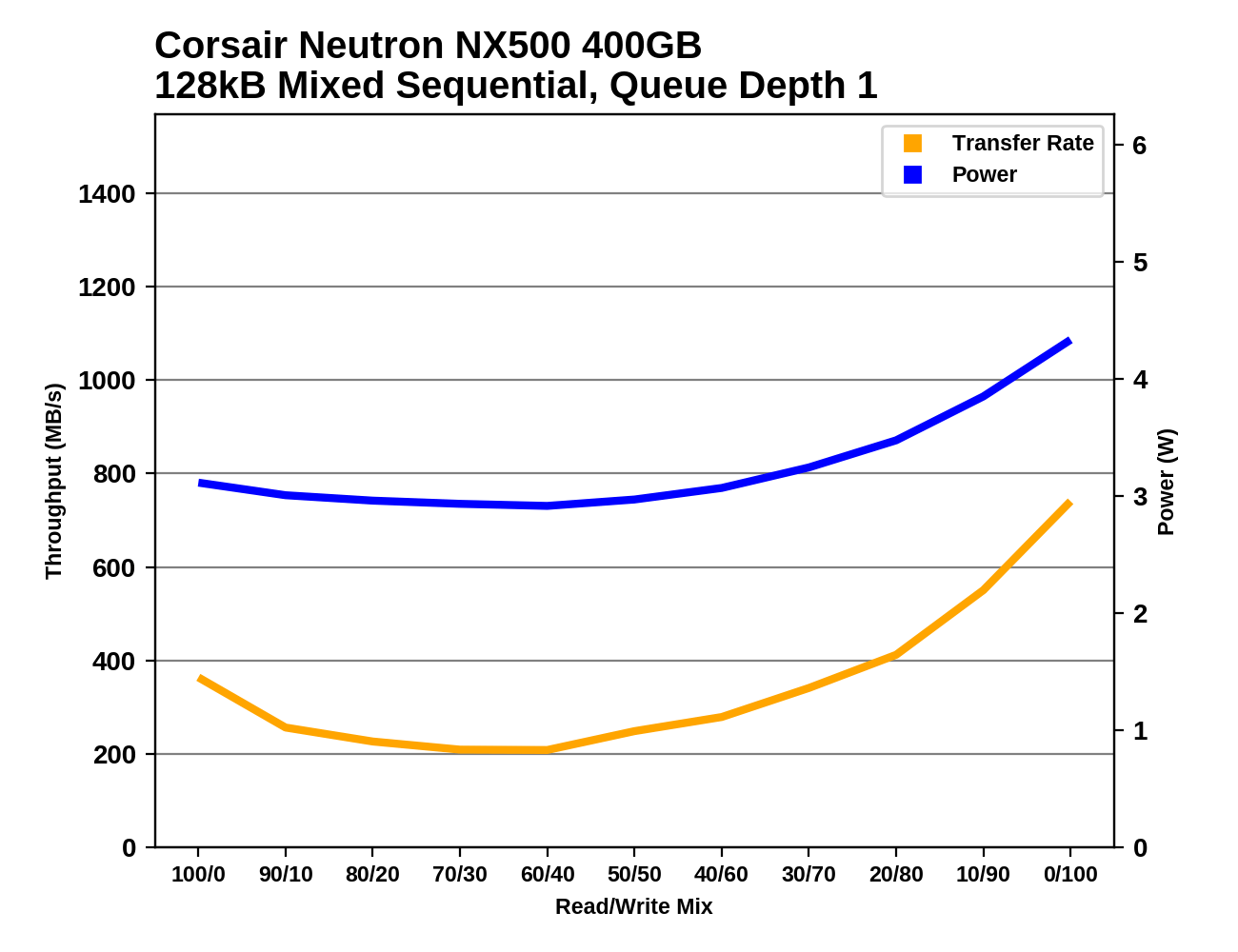The Corsair Neutron NX500 (400GB) PCIe SSD Review: Big Card, Big Pricetag
by Billy Tallis on August 16, 2017 10:00 AM ESTMixed Random Performance
Our test of mixed random reads and writes covers mixes varying from pure reads to pure writes at 10% increments. Each mix is tested for up to 1 minute or 32GB of data transferred. The test is conducted with a queue depth of 4, and is limited to a 64GB span of the drive. In between each mix, the drive is given idle time of up to one minute so that the overall duty cycle is 50%.

The QD4 mixed random I/O performance of the Corsair Neutron NX500 is pretty good overall, but the Patriot Hellfire has a clear advantage. The Zotac SONIX on the other hand can't beat the SATA-based Samsung 850 PRO and is only slightly faster than the Intel 600p.

The power efficiency of the NX500 during the mixed random I/O test is about average, while the faster Patriot Hellfire beating all the other planar NAND SSDs in this bunch.
 |
|||||||||
The performance of the Neutron NX500 increases gradually as the portion of writes increases, not dropping anywhere along the way but also not spiking very high in the final phase of the test where many drives improve greatly.
Mixed Sequential Performance
Our test of mixed sequential reads and writes differs from the mixed random I/O test by performing 128kB sequential accesses rather than 4kB accesses at random locations, and the sequential test is conducted at queue depth 1. The range of mixes tested is the same, and the timing and limits on data transfers are also the same as above.

The mixed sequential performance of the Corsair Neutron NX500 is poor, with it and the Patriot Hellfire performing slightly worse than the SATA-based Samsung 850 PRO and only beating the entry-level TLC NVMe drives. The Zotac SONIX on the other hand performed quite well, though still a bit slower than what the OCZ RD400A manages using the same NAND.

The power efficiency of the NX500 and Patriot Hellfire rank no better than their overall performance on the mixed sequential test, and the Zotac SONIX is only modestly better off.
 |
|||||||||
The NX500's performance on the mixed sequential test bottoms out with 70/30 and 60/40 read/write mixtures, but then shows good improvement as the proportion of writes continues to increase. Most of the MLC drives are able to avoid the performance drop that the NX500 suffers in the early phases of this test, which is what leads to the Zotac SONIX scoring so much better than the NX500.










45 Comments
View All Comments
Exodite - Wednesday, August 16, 2017 - link
I'm looking forward to the day I can read a SSD review and not come away thinking "...or just buy a Samsung".Not that I begrudge them top spot, they've clearly put the work into it, but as consumers we'd be better served if at least /someone/ else were competing on, like, any metric.
Ej24 - Wednesday, August 16, 2017 - link
Crucial used to be in the game back when Sata SSD's were king, then they just never released another MLC drive, nor any consumer nvme drives. So yeah, Samsung is definitely unchallenged now. Though that Toshiba xg5 kept up well in the destroyer benchmark.coolhardware - Wednesday, August 16, 2017 - link
Agreed. Samsung has been at the top for so long it is just boring.Kudos to Samsung though for making some fast and reliable SSDs at a reasonable price point.
Lolimaster - Wednesday, August 16, 2017 - link
I think we got more chances to see GloFo AMD branded SSD better than the 850 than waiting for the known competitors.Samus - Wednesday, August 16, 2017 - link
Crucial is still in the game. They just can't compete with Samsung on performance. Nobody can.But in my experience, Crucial/Micron drives are slightly more reliable that Samsung (obviously excusing the flawed 840\840 EVO) especially in regard to power loss scenarios. That's why you continue to see more Micron drives in enterprise and business PC's than any other brand (except perhaps Sandisk, in which case they are often the same Marvell controller so the differentiating factor comes down to firmware and in-flight data protection)
It's really hard to consider anything else when looking at "new" drives. Samsung and Crucial/Micron are really at the top. Sandisk is decent, but not cost competitive at the high end, and OCZ's has had some good drives for the price lately, but why gamble?
And if you are looking for cheap MLC drives, older Intel drives are still the best bet. I still have a soft spot for SSD320's and SSD710's if you can live with the 3Gbps interface they are bulletproof and incredibly cheap on fleabay.
DigitalFreak - Wednesday, August 16, 2017 - link
"That's why you continue to see more Micron drives in enterprise and business PC's than any other brand (except perhaps Sandisk, in which case they are often the same Marvell controller so the differentiating factor comes down to firmware and in-flight data protection)"Maybe it's the particular vendor, but the Dell and Cisco equipment I deal with in both the server and desktop space use mainly Samsung, with some Toshiba XG series on the client side.
tipoo - Wednesday, August 16, 2017 - link
It's maybe ironic the only one challenging them on SSD speed isn't selling SSDs outside their own systems, i.e the last custom Apple SSD controller.tipoo - Wednesday, August 16, 2017 - link
Actually I'd love to see that put through this suite.extide - Wednesday, August 16, 2017 - link
Well at least I can be satisfied knowing I made a good investment buying my 1TB 960 EVO -- heck I think I paid around $400 - $450 or so for it -- cheaper than the 800GB version of this. It makes reviews boring but at the same time it sucks spending good money on something and then seeing something cheaper and faster released shortly after, although I do agree that we need to see some competition.beginner99 - Thursday, August 17, 2017 - link
Yeah. Perfromance is one thing but price another and this drive is clearly overpriced. If you want me to use a pcie-card ssd you better deliver something special but this fails.What's missing is a strady-state bench. First the large spare area gets praised but then no steady-state data? IMHO that is usually the most important aspect of the review, the actual performance the drive will have not some "marketing" numbers.